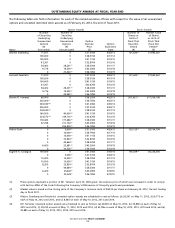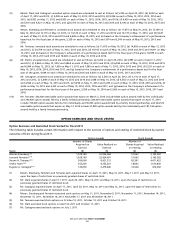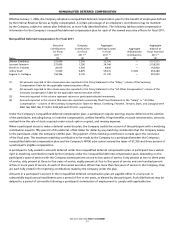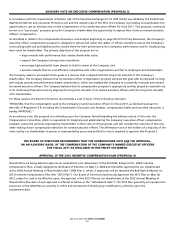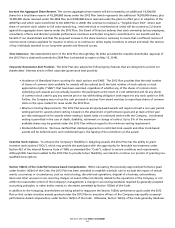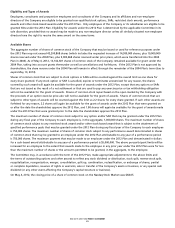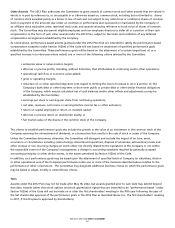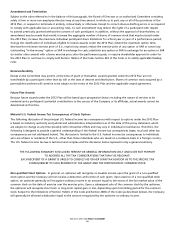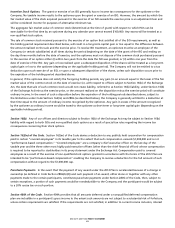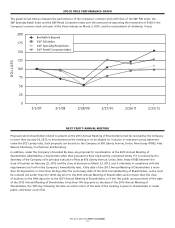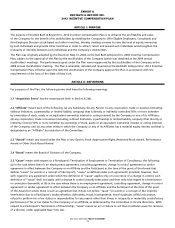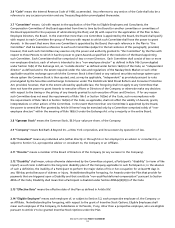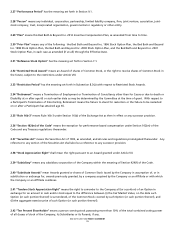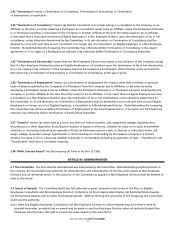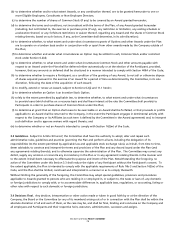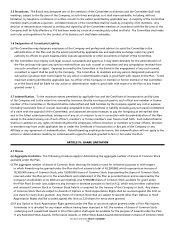Bed, Bath and Beyond 2011 Annual Report Download - page 71
Download and view the complete annual report
Please find page 71 of the 2011 Bed, Bath and Beyond annual report below. You can navigate through the pages in the report by either clicking on the pages listed below, or by using the keyword search tool below to find specific information within the annual report.BED BATH & BEYOND PROXY STATEMENT
69
Incentive Stock Options. The grant or exercise of an ISO generally has no income tax consequences for the optionee or the
Company. No taxable income results to the optionee upon the grant or exercise of an ISO. However, the amount by which the
fair market value of the stock acquired pursuant to the exercise of an ISO exceeds the exercise price is an adjustment item and
will be considered income for purposes of alternative minimum tax.
The aggregate fair market value of common stock (determined at the time of grant) with respect to which ISOs can be
exercisable for the first time by an optionee during any calendar year cannot exceed $100,000. Any excess will be treated as a
non-qualified stock option.
The sale of common stock received pursuant to the exercise of an option that satisfied all of the ISO requirements, as well as
the holding period requirement described below, will result in a long-term capital gain or loss equal to the difference between
the amount realized on the sale and the exercise price. To receive ISO treatment, an optionee must be an employee of the
Company (or certain subsidiaries) at all times during the period beginning on the date of the grant of the ISO and ending on
the day three months before the date of exercise, and the optionee must not dispose of the common stock purchased pursuant
to the exercise of an option either (i) within two years from the date the ISO was granted, or (ii) within one year from the
date of exercise of the ISO. Any gain or loss realized upon a subsequent disposition of the shares will be treated as a long-term
capital gain or loss to the optionee (depending on the applicable holding period). The Company will not be entitled to a tax
deduction upon such exercise of an ISO, or upon a subsequent disposition of the shares, unless such disposition occurs prior to
the expiration of the holding period described above.
In general, if the optionee does not satisfy the foregoing holding periods, any gain (in an amount equal to the lesser of the fair
market value of the common stock on the date of exercise (or, with respect to officers subject to Section 16(b) of the Exchange
Act, the date that sale of such common stock would not create liability, referred to as Section 16(b) liability, under Section 16(b)
of the Exchange Act) minus the exercise price, or the amount realized on the disposition minus the exercise price) will constitute
ordinary income. In the event of such a disposition before the expiration of the holding periods described above, subject to
the limitations under Code Sections 162(m) and 280G (as described below), the Company is generally entitled to a deduction at
that time equal to the amount of ordinary income recognized by the optionee. Any gain in excess of the amount recognized
by the optionee as ordinary income would be taxed to the optionee as short-term or long-term capital gain (depending on the
applicable holding period).
Section 16(b). Any of our officers and directors subject to Section 16(b) of the Exchange Act may be subject to Section 16(b)
liability with regard to both ISOs and non-qualified stock options as a result of special tax rules regarding the income tax
consequences concerning their stock options.
Section 162(m) of the Code. Section 162(m) of the Code denies a deduction to any publicly held corporation for compensation
paid to certain “covered employees” in its taxable year to the extent that such compensation exceeds $1,000,000 and is not
“performance-based compensation.” “Covered employees” are a company’s chief executive officer on the last day of the
taxable year and the three other most highly paid executive officers (other than the chief financial officer) whose compensation
is required to be reported to stockholders in its proxy statement under the Exchange Act. Compensation paid to covered
employees as a result of the exercise of non-qualified stock options granted in accordance with the terms of the 2012 Plan are
intended to be “performance-based compensation” enabling the Company to receive a deduction for the full amount of such
compensation without regard to the $1,000,000 cap.
Parachute Payments. In the event that the payment of any award under the 2012 Plan is accelerated because of a change in
ownership (as defined in Code Section 280G(b)(2)) and such payment of an award, either alone or together with any other
payments made to the certain participants, constitutes parachute payments under Section 280G of the Code, then, subject to
certain exceptions, a portion of such payments would be nondeductible to the Company and the participant would be subject
to a 20% excise tax on such portion.
Section 409A of the Code. Section 409A provides that all amounts deferred under a nonqualified deferred compensation
plan are includible in a participant’s gross income to the extent such amounts are not subject to a substantial risk of forfeiture,
unless certain requirements are satisfied. If the requirements are not satisfied, in addition to current income inclusion, interest


